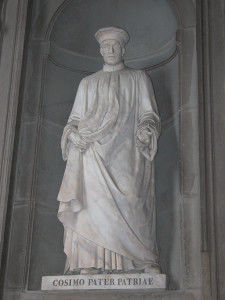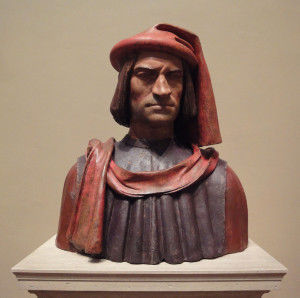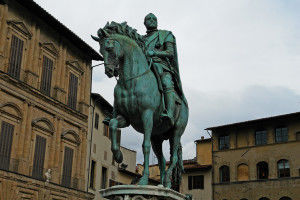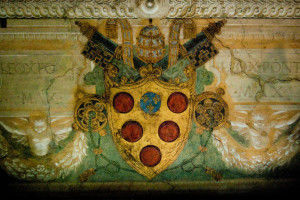Which Family Ruled Florence During Most of the Fifteenth Century?
Here you find data and history virtually the Medici family, the world famous Italian noble family that had a great power in Florencefrom the 15th to the 18th century.
Contents
- 1 Who were the Medici?
- 2 The Medici dynasty: origins and history
- ii.i Giovanni di Bicci
- 2.2 Cosimo the Elder
- two.3 Lorenzo the Magnificent
- 2.four Cosimo I
- 2.5 Francesco I
- two.half dozen Ferdinando I
- 2.7 Ferdinando 2
- 2.8 Anna Maria Luisa, the concluding descendant
- 3 What is the Medici family best known for?
- four Why were the Medici important to the Renaissance?
- five The glaze of artillery of the Medici
- six The TV drama Medici: Masters of Florence
- 7 An House of Medici volume
- 8 Medici family unit tours
Who were the Medici?
The Medici family unit, also known as the House of Medici, was the Italian family unit that ruled Florence, and later Tuscany, during near of the menstruum from 1434 to 1737, except for 2 brief intervals (from 1494 to 1512, and from 1527 to 1530).
They first attained wealth and political ability in Florence through their success in commerce and banking. Commencement in 1434 with the rise to power of Cosimo de' Medici (or Cosimo the Elder), the family's back up of the arts and humanities transformed Florence into the cradle of the Renaissance, a cultural flowering rivaled only by that of ancient Hellenic republic.
The Medici produced 4 popes (Leo X, Clement Vii, Pius IV, and Leon XI), and their genes have been passed through many of Europe's royal families. The terminal Medici ruler, Gian Gastone, died without a male person heir in 1737, ending the family dynasty after almost iii centuries and beginning the long European reign of the Hapsburg-Lorraine family.
The Medici dynasty: origins and history
The earliest records we accept of the Medici family unit tell united states of america that they came from the Mugello valley and arrived in Florence around 1200.
The primeval origins of this family are difficult to track considering the Medici later tried to ennoble their lineage by inventing legends and stories.

The founder of the family would be Doc di Potrone, who lived effectually the year 1000 and was a physician by profession. Medici is the Italian word for doctors.
As often happened, the Medici went into Florence in search of fortune, and we must say that they found it! Almost immediately they were enrolled in the guild of doctors and apothecaries.
Historical chronicles recount that they went to live at the Onetime Market place (in the area close to Piazza della Repubblica) and easily mingled with the underworld at that place.
As many as five expiry sentences were reported out of respect of the Medici family unit! In a deed dated 1201, a homo named Giambuono is considered to exist the historical founder of the family. At the end of thirteenth century, 2 members of the family (Scolaio and Gano) were office of the Guelph party, the same family every bit Dante Alighieri.
In 1348, the twelvemonth of the terrible Black Decease, ane of the Medici was Gonfaloniere di Giustizia , one of the citizens selected who formed the regime, or Signoria. The Signoria, comprised of nobles, important burghers, and intellectuals, was the oligarchic establishment that ran the Florentine republic.
Giovanni di Bicci
Members of the Medici family were the protagonists of Florentine life long before their dynasty passed into history.
Giovanni di Bicci (1360–1429) is the commencement fellow member of the family unit who created a dense network of merchants around him and his family.
The Medici family became a wealthy family of bankers, and Giovanni was 1 of the richest Florentines in the early on fifteenth century.
With a ready source of capital, the Medici were able to turn to such new lines of commerce every bit trading spices, jewelry, silk, and fruit. In addition, their ever-increasing fiscal ability opened up new opportunities in borough government.
Giovanni'south two sons, Cosimo (1389–1464), who acquired the appellation of "the Elderberry", and Lorenzo (1394–1440), founded the famous bloodlines of the Medici family.
Cosimo the Elder
With Cosimo the Elderberry, the Medici became the bankers of the Vatican and as such became famous throughout Europe. Wealth and prestige are the commandments of this family: Cosimo was famous non merely for his skills equally a businessman simply also for his patronage and artistic taste. And so were all his successors.

Marble statue of Cosimo the Elder (Cosimo il Vecchio) – Uffizi Gallery
Forth with the success of the Medici was too a growing opposition from other Florentine families and factions. Some families who supported the Medici were Tornabuoni, Salviati, Cavalcanti, Bardi. Some opponents were Albizi, Guicciardini, and Corsi. Today, we find all of these family names represented past the names of streets in Florence.
Equally a result of these power struggles, some of the Medici were subjected to exile, but after a short time Cosimo and his brother Lorenzo returned to Florence. We must break to speak of Cosimo the Elder (Cosimo il Vecchio): He built the not bad wealth of the family, but his fame is also linked to his wisdom.
He was a great man without wanting to appear so. He built a palace (located in via Larga) for himself just wanted it to expect similar the dwelling house of a merchant. He enriched Florence with works of fine art and also donated to libraries and churches.
When Cosimo died in 1464, the Florentines gave him honors fit for a king, and he was thereafter chosen pater patriae. The prestige of the Medici before long extended beyond the confines of Florence, and some members of the family were elected pope, such equally Leo X and Clement VII.
Lorenzo the Magnificent

Bust of Lorenzo the Magnificent (Lorenzo il Magnifico)
The story reminds united states of Lorenzo the Magnificent (Italian: Lorenzo il Magnifico, 1449–1492) as the greatest of the Medici. He was a poet, humanist, skilled politician, writer, and patron of the arts.
At the fourth dimension of Lorenzo, the Medici overcame the opposition of the monk Savonarola and the famous Pazzi conspiracy (1478) during which Lorenzo was wounded, and his blood brother Giuliano lost his life.
Growing internal opposition forced the Medici to leave Florence subsequently the decease of Lorenzo the Magnificent. The new Republic, however, lasted only a few decades, and the Medici family came back, thanks to assistance from the king of France.
After these events, a period of misfortune followed for the Medici, as they became more than involved in European diplomacy and were forced into exile several times.
Cosimo I
The fate of the family changed, thanks to Cosimo I (1519–1574), who descended from Cosimo the Elderberry and Lorenzo the Magnificent but not directly.
He was the son of Giovanni delle Bande Nere, a mercenary captain. Despite his quite apprehensive origin, though, Cosimo managed to reign over Florence and married a princess.

Equestrian statuary statue of Cosimo I de' Medici past Giambologna – Piazza della Signoria
He was vigorous and astute, often used force against his opponents, and always wanted to celebrate his power. We know him as Cosimo I, Grand Duke of Tuscany. Under his authorities, Florence was united as never before.
Cosimo married Eleonora of Toledo―who came from 1 of the most noble Castilian families―and together they decided to live in the Palazzo Vecchio, which was also a symbol of power in the city when Florence was a commonwealth.
The thou project of Cosimo was to unify all of Tuscany, and to that end he undertook wars with Pisa, Lucca, and Siena. He managed them all, and his victories are celebrated in the frescoes of the Hall of the V Hundred, including the magnificent Battle of Marciano.
Francesco I
There were many sons of Grand Knuckles Cosimo, but 3 of them, along with their mother Eleanor, died of malarial fever during a family trip in Maremma, where Cosimo had ordered the reclamation of the marshes. Grief stricken, Cosimo decided to retire from politics and left his son Francesco I in command. During this period, the Pitti Palace had become their residence, and the city was enriched by buildings and streets worthy of the best European capitals. Cosimo died in 1574, and with his disappearance begins the decline of the dynasty. Francesco I liked chemistry and science rather than politics, simply he knew he could not evidence his weakness and was sometimes ruthless.
Ferdinando I
Ferdinando I, brother of Francesco, was his successor. The fate of the family unit seemed to recover, thank you to European alliances. In the meantime, two women of the family unit became queens of France: Caterina and Maria. Caterina, however, was a strong adversary of Cosimo I. Ferdinando married Christina of Lorraine and had numerous descendants.
Ferdinando II
The successor to the throne―Ferdinando Two―was also immature to reign, so his female parent and grandmother reigned for him and―merely to summarize―acquired a lot of trouble! He died without heirs. Some members of the Medici family unit tried to keep up the family name, but it was most the cease of the dynasty, and the city of Florence was in the midst of disputes and barters of the ruling houses all over Europe.
Anna Maria Luisa, the terminal descendant
The last keen act of the Medici for their city was made by the terminal descendant Anna Maria Luisa de' Medici. She made an understanding with the Lorraine family―the new sovereigns of Florence―and forced them to leave intact the heritage of the Medici family, which had to be kept in Florence. Thanks to that organization, Florence now hosts the Uffizi Gallery, the Pitti Palace museums, and many other earth-famous museums. It was the last precious souvenir from the Medici family to their dear Florence.
What is the Medici family unit best known for?
The Medici are best known for being patron of the arts. Their financial support of the arts and humanities helped to make Renaissance-era Florence a thriving cultural center.
Florence was known every bit the centre of the Renaissance, attracting thinkers and artists akin to the city through the reputation of its chivalrous rulers, and producing thinkers and artists from schools sponsored by the Medici and others. The city welcomed the ideals and philosophies of distant lands, absorbing them into the writing and art that it produced.
While the Medici used their talents to gain power and prestige for themselves, they besides used their influence to improve the quality of life of those in their charge to sponsor cultural endeavors and to keep Florence free from foreign domination.
Why were the Medici important to the Renaissance?
The biggest accomplishments of the Medici lay in the sponsorship of art and architecture. They were responsible for the majority of Florentine art during their reign.
Giovanni di Bicci de' Medici, the kickoff patron of the arts in the family, helped Masaccio and deputed Brunelleschi for the reconstruction of the Basilica of San Lorenzo in Florence in 1419.
Cosimo the Elderberry commissioned Filippo Brunelleschi for the building of the dome of Santa Maria del Fiore cathedral. He too demonstrated tremendous support for education, establishing the Platonic Academy for the written report of ancient works. Information technology is estimated that before his death in 1464, Cosimo spent approximately 600,000 gold florins supporting architecture, scholarly learning, and other arts. Cosimo the Elder'south notable artistic assembly were Donatello and Fra Angelico.
The near significant addition to the listing over the years was Michelangelo Buonarroti (1475–1564), who produced works for a number members of the Medici, get-go with Lorenzo the Magnificent, inviting him to study the family collection of antique sculpture and whom the Medici deputed to complete their family tombs in Florence.
Lorenzo also served as patron to Leonardo da Vinci (1452–1519) for seven years. Lorenzo was indeed an artist in his own right, and was an author of poetry and song. His back up of the arts and letters is considered a high indicate in Medici patronage.
Later, in Rome, the Medici Popes connected in the family tradition of patronizing artists in Rome. Pope Leo X would chiefly committee works from Raffaello.
Pope Cloudless VII commissioned Michelangelo to paint the chantry wall of the Sistine Chapel. Eleanor of Toledo, princess of Espana and wife of Cosimo I the Nifty, purchased the Pitti Palace from Buonaccorso Pitti in 1550. Cosimo in plough patronized Vasari, who erected the Uffizi Gallery in 1560 and founded the Accademia delle Arti del Disegno in 1563.
Marie de' Medici, widow of Henry 4 of French republic and mother of Louis XIII, is the subject field of a commissioned cycle of paintings known equally the Marie de' Medici bike, painted for the Luxembourg Palace by court painter Peter Paul Rubens in 1622-23.
The family is well recognized for having been the patrons of the famous Galileo Galilei, who tutored multiple generations of Medici children.
In improver to commissioning art and architecture, the Medici were prolific collectors, and today their acquisitions class the core of the Uffizi museum in Florence. In architecture, the Medici are responsible for some notable features of Florence, including the Uffizi Gallery, the Boboli Gardens, the Belvedere, the Medici Chapel, and the Palazzo Medici.
The coat of arms of the Medici
The coat of artillery of the Medici family unit has undergone several changes, and there are many dissimilar versions: the near famous is the one with 6 reddish balls on a gilded background.

The Medici'southward coat of arm
Theories about the origins of this blazon have multiplied over time, and some are quite funny. Some say that the six balls were medicinal pills and alluded to the meaning of the family name; others said that they were the symbol of bitter oranges to bespeak trade with the Due east.
The Medici themselves invented a not crediblefable to ennoble the story of their origins: the red balls were signs of blows inflicted on the shield of the progenitor Averardo past a behemothic who lived in Mugello.
Nosotros know that many Florentine families had balls of different colors and numbers in their coats of arms. Maybe they were derived simply from the studs on the shield that were colored for becoming decorative.
The almost probable hypothesis says that the Medici had some reddish bisanti on the crest (the bisanti are metal discs whose name derives from the Byzantine coins), and that this design is derived from the symbol of the gild of moneychangers and bankers, which features gilded bisanti on a cherry background.
We cannot count subsequently versions of the Medici coat of arms as well as the different branches of the family. One successful version is decorated with a blue brawl from the lilies of France, thanks to the concession of the king of French republic.
As if that were non plenty, the number of balls contained in the coat of arms is not always the same throughout history. Originally there were eleven and then ix. Cosimo the Elderberry reduced the number to eight. Information technology was Lorenzo the Magnificent who made the concluding modify: simply half-dozen assurance.
The TV drama Medici: Masters of Florence
Medici: Masters of Florenceis an eight-part drama series chronicling the rise of the Italian Renaissance political dynasty known as the Medici family.
It was produced past Matilde and Luca Bernabei's Lux Vide, and Frank Spotnitz's Big Light Productions. Richard Madden played enterprising son Cosimo de' Medici, while Dustin Hoffman played a pivotal role equally family patriarch Giovanni de' Medici. The story focuses on the family's rising from uncomplicated merchants to power brokers who sparked an economic and cultural revolution. Along the style, the family likewise accrues a long list of powerful enemies.
"The legacy of the Medici family is so profound that its touch on the Renaissance is immeasurable. The foundations they laid in business and culture achieve into the modern world today, which gives our story nifty latitude and depth, said Matilde and Luca Bernabei, Lux Vide's Chairman and CEO, respectively. "After seven centuries, their story remains a compelling one, full of intrigue, power, art, and faith. The historic and creative heritage they left us still lives on, and we promise that it volition inspire a new Renaissance in Italy, Europe, and throughout the world. Because of the project's cultural importance, nosotros wanted to bring the all-time talents to the series; excellent author/executive producer Frank Spotnitz, and the incomparable actors Dustin Hoffman and Richard Madden.
RAI Idiot box, the Italian national Television set network, aired episodes 1 and 2 on Tuesday, October 18, 2016. Co-ordinate to the Italian ratings compiler Auditel, it attracted a record seven.6 meg viewers. Rai Television set will air 2 episodes each Tuesday, and with season i comprising 8 episodes, information technology volition have 4 weeks to be broadcast. The series has been sold to many European channels, while sales in the USA accept been delegated to WME. However, there is presently no give-and-take on when information technology will be aired in other countries. The episodes are threescore minutes long. The theme was the song Renaissance played by the English singer Pare.
Flavor i focuses on the rise of the Medici, with the protagonists being Giovanni (1360-1429, Dustin Hoffman) and his son Cosimo (1389-1464, Richard Madden). Flavor two, which has been commissioned for the end of 2016, will focus on the life of Lorenzo, grandson of Cosimo.
Filming spanned eighteen weeks between Rome and Florence, where producers had the opportunity to shoot in historical sites such every bit Palazzo Vecchio, Bargello Palace, the church building of San Lorenzo, and inside the Duomo. Other shoots occurred in Pienza, Montepulciano, Pistoia, Bagno Vignoni, San Quirico d'Orcia, and the UNESCO site of Val d'Orcia.
The historical drama was made in English considering of the international sales potential with its outstanding international cast. Rai 1 appear on October 28, 2016, that information technology is now possible to watch Medici Masters of Florence in the English language on his online platform Raiplay. Previously, this was only possible by choosing the language option during the alive show and only with a terrestrial or satellite decoder.
An House of Medici book
If yous desire to learn more than about the Medici family, nosotros recommend an interesting volume, The Business firm of Medici: Its Ascension and Fall . Information technology is available on Amazon.

The Firm of Medici: Its Rise and Autumn
by Christopher Hibbert
This enthralling book charts the family's huge influence on Florence. Beginning with the ascent of the dynasty under the legendary Cosimo de Medici, it moves through their golden era.
Medici family tours
Here some guided tours concerning the Medici family provided by GetYourGuide, a portal which offers museum entrance tickets, guided visits, and other other blazon of activies, in Florence and all around the world:
Free cancellation up to 24 hours in advance
—
This post was originally published in September 3, 2013, and has been updated and enriched on November 14, 2016.
Pictures: Palazzo Vecchio by Shirley de Jong (CC BY-NC 2.0); Cosimo the Elderberry by Robert Scarth (CC By-SA 2.0); Lorenzo de' Medici by Jim Woods (CC Past-NC-ND 2.0); Medici glaze of arms past Michael Colburn (CC Past-NC-ND 2.0); Bronze of Cosimo de Medici, Piazza della Signoria (CC BY-ND 2.0.).





shannonalibut1990.blogspot.com
Source: https://www.florenceinferno.com/the-medici-family/
0 Response to "Which Family Ruled Florence During Most of the Fifteenth Century?"
Post a Comment